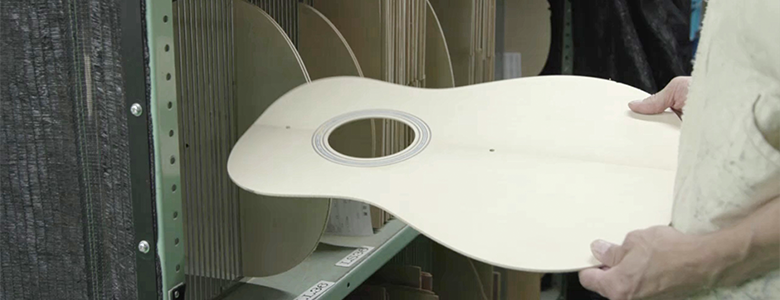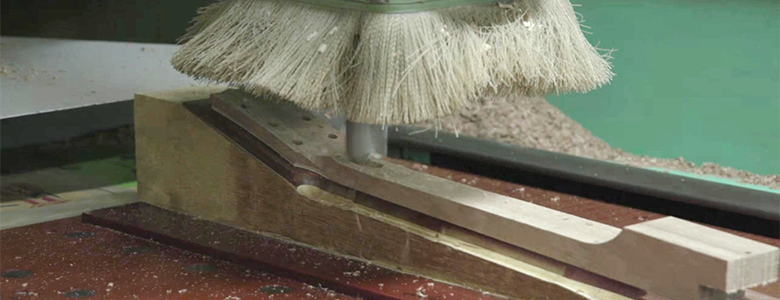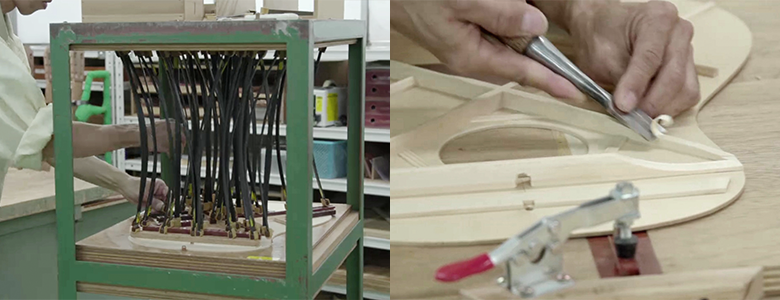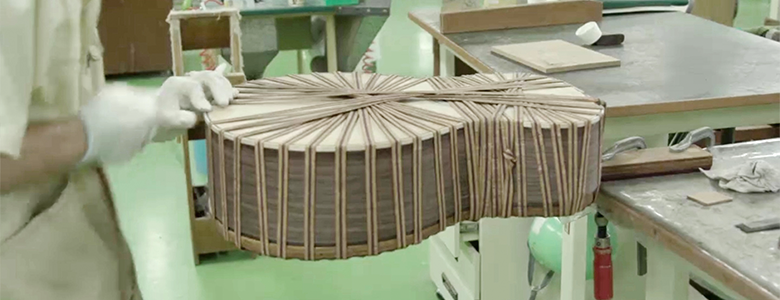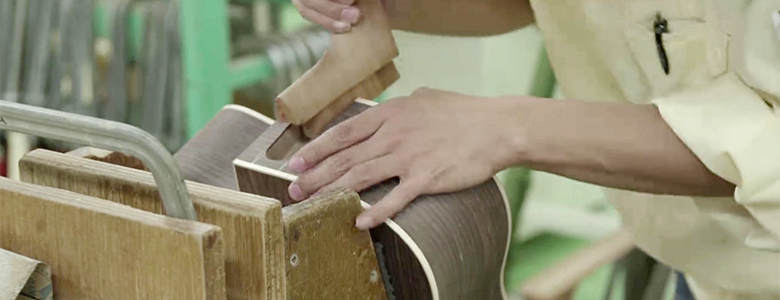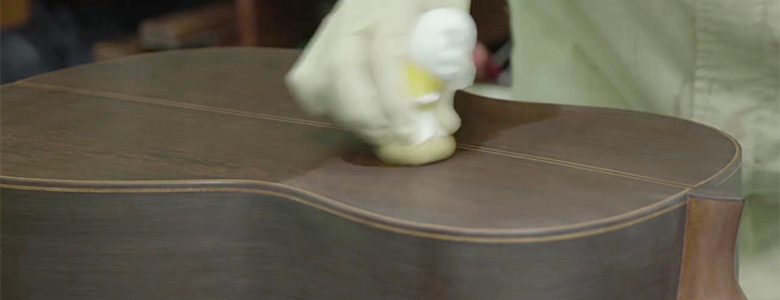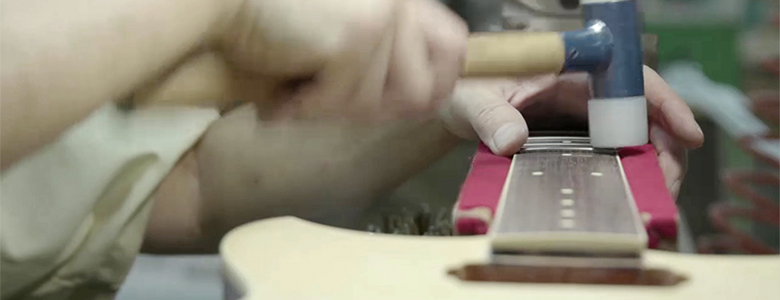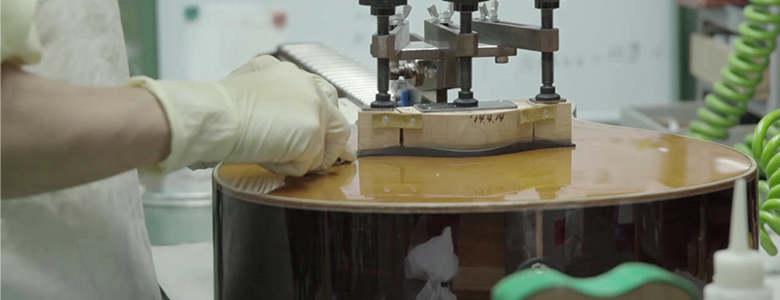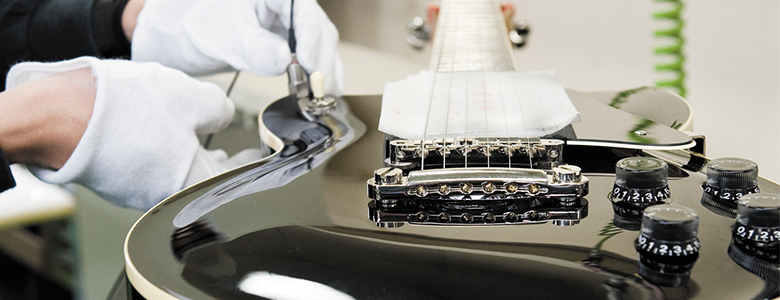Trình độ tay nghề
CRAFTSMANSHIP
Ngay cả với các kỹ thuật sản xuất tiên tiến, chúng ta vẫn không thể tự động hóa việc sản xuất những cây đàn guitar tuyệt vời. Sự phức tạp của công việc, cùng với những đòi hỏi nhận biết, cập nhật về nguyên vật liệu, sự tỉ mỉ trong từng chi tiết biến đổi chứng tỏ mọi máy móc, công nghệ hiện đại đều không thể tahy thế kỹ năng và độ nhạy bén của những người thợ thủ công lành nghề.

-
Biến Ý tưởng thành những cây Đàn Guitar tuyệt vời
Biến những ý tưởng thiết kế thành hiện thực nhạc cụ tuyệt vời không phải là việc dễ dàng. Bản vẽ kỹ thuật không thể truyền tải âm sắc nhạc cụ hay các phương pháp chế tạo cần thiết để tạo ra các đặc tính và âm thanh như mong muốn. Trước khi bắt đầu sản xuất một cây đàn guitar mới, nhà thiết kế và các thợ làm đàn thủ công sẽ thảo luận về kế hoạch và dự định của họ tại nhà máy để phát triển một quy trình sản xuất phù hợp. Mỗi đàn guitar mỗi khác, và việc đưa ra phương pháp và quy trình sản xuất lý tưởng cho mỗi cây đàn là rất quan trọng.

-
Quá chi tiết

Đôi khi, làm "quá chi tiết" mọi thứ là cách duy nhất để đảm bảo đạt được chất lượng đồng nhất như mong muốn trong mọi tình huống. Yamaha chú trọng sản xuất từng chi tiết đến mức cực đoan trong nhiều trường hợp, nhưng kết quả cuối cùng thật xứng đáng. Ví dụ như quy trình ướm ghép thân đàn và cần đàn guitar thùng trước khi hoàn thiện của Yamaha, tại đây, cần đàn và thân đàn được ướm ghép trước với nhau trong quá trình chế tạo. Bằng kinh nghiệm có thể khẳng định chất lượng của khớp nối giữa cần đàn và thân đàn đóng vai trò quan trọng trong việc tối ưu chất âm và độ nhạy của đàn; tóm lại, sự ghép nối cần đạt đến độ hoàn hảo, tiếp xúc chặt chẽ giữa cần đàn và thân đàn. Những nỗ lực này hoàn toàn xứng đáng khi kết quả đạt được là việc chất lượng luôn được kiểm soát và đồng nhất trong cả quá trình sản xuất và hoàn thiện cần đàn, thân đàn thành một thể hoàn chỉnh.
-
Sự kết hợp ăn ý giữa yếu tố Chuẩn xác của Máy móc và Kỹ năng của Người thợ
Có một số công việc mà máy móc có thể làm rất tốt, đặc biệt là những công việc đòi hỏi độ chính xác và độ lặp lại, tương đồng cao; ví dụ, việc cắt các khe cắm phím đàn trong bàn phím là một công việc quan trọng được xử lý bởi công nghệ điều khiển sự chính xác của máy móc. Nhưng để tạo ra các nhạc cụ thực sự đáp ứng nhu cầu của người chơi guitar, có những yếu tố đòi hỏi sự cẩn trọng và linh hoạt của từng cá nhân. Đó là công việc mà ở đó kỹ năng và kinh nghiệm của những người thợ thủ công Yamaha thực sự tỏa sáng.

-
Xử lý lớp phủ hoàn thiện
Yamaha nỗ lực làm việc để đảm bảo rằng mọi cây đàn guitar và đàn bass xuất xưởng luôn trong trạng thái sử dụng tốt nhất. Một số người chơi có thể muốn thực hiện các điều chỉnh nhỏ để phù hợp với phong cách chơi của họ, nhưng các chi tiết quan trọng như vị trí phím đàn và lớp phủ hoàn thiện luôn được tinh chỉnh ở mức hoàn hảo nhất. Bước lắp ráp cuối cùng đòi hỏi sự cẩn thận tối đa để đạt được hiệu suất và âm sắc tối ưu. Các bộ phận không được ghép nối chính xác hoặc chắc chắn có thể làm giảm chất lượng cả âm thanh và khả năng chơi của đàn, do đó, công nghệ và quy trình lắp ráp được thiết kế và thiết lập một cách trơn tru và hiệu quả, giúp người sản xuất tập trung hơn cho một kết quả hoàn hảo.

-
Chế tạo Công cụ
Hầu hết các công cụ dùng để làm đàn guitar phải được chế tạo bằng tay cho từng mục đích, và nhiều công cụ được tạo riêng cho một kiểu đàn duy nhất, không thể sử dụng cho các kiểu đàn khác. Việc phát triển các công cụ và đồ gắn lắp đặc thù giúp các nhà sản xuất đàn guitar dễ dàng tạo ra các nhạc cụ hoàn hảo là một yếu tố quan trọng trong việc tiếp cận các ngành nghề thủ công của Yamaha, nhưng các công cụ và đồ gắn lắp có thể bị mòn và không còn phù hợp cho việc sử dụng, vì vậy cần phải có sự chăm sóc đặc biệt để duy trì các công cụ này luôn ở trong điều kiện làm việc hoàn hảo: đây là phần việc không thể hiện ra ngoài nhưng rất quan trọng trong hoạt động kiểm soát chất lượng tổng thể.

-
Duy trì ngành nghề thủ công
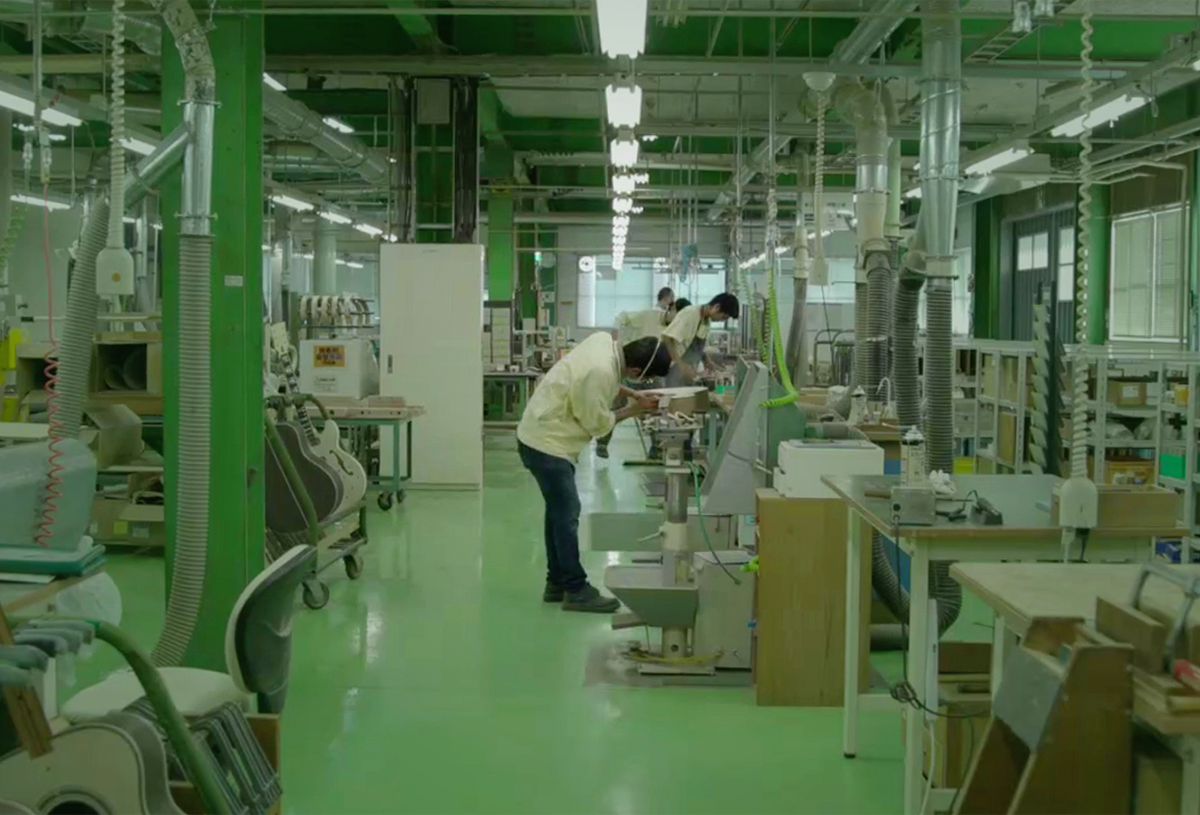
Việc sản xuất nên những cây đàn guitar tốt phụ thuộc vào kỹ năng và tay nghề thủ công, do đó, cách duy nhất để duy trì và đảm bảo chất lượng đồng nhất trong tương lai chính là truyền lại bí quyết cho thế hệ thợ tiếp nối. Loại kỹ năng này chỉ có thể truyền lại và kế thừa bởi con người, thông qua học nghề thực hành, vì vậy Yamaha biến hoạt động này thành một phần chính thức của quy trình sản xuất đàn guitar. Đội ngũ các nhà chế tạo đàn guitar thay đổi theo thời gian, nhưng Yamaha luôn tận tâm để đảm bảo rằng các kỹ năng cơ bản, cũng như nhiều sáng kiến luôn cải thiện theo thời gian và được truyền lại giữa các thể hệ một cách hiệu quả để đàn guitar Yamaha có thể tiếp tục phát triển.
-
Quy trình sản xuất đàn guitar
